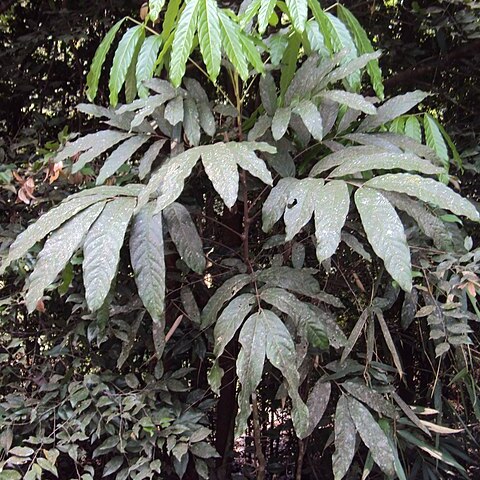Trees or shrubs, monoecious. Leaves usually paripinnate, alternate, estipulate, usually petiolate; leaflets 2 to several pairs, opposite or alternate, usually entire. Thyrses axillary, above axils or on old branches, solitary or several in fascicles. Flowers unisexual, actinomorphic or zygomorphic. Sepals 5, leathery, concave, imbricate, outer 2 smaller, orbicular, inner ones usually broadly ovate or elliptic. Petals 4 or 5, often spoon-shaped, longer than sepals, base clawed, apex with adaxial scale. Disk acetabuliform or semilunar, entire or lobed. Stamens (male flowers) 8, rarely more or fewer, with disk, longer than petals; filaments flat, usually hairy; anthers ellipsoid. Ovary (female flowers) 2-or 3-loculed, usually with grooves between locules; ovules 1 per locule; style short, apex inflated, entire or 2-or 3-lobed. Fruit ellipsoid or subglobose, 2-or 3-loculed; pericarp leathery or slightly fleshy, both sides or only abaxially hairy, rarely glabrous on both sides. Seeds ellipsoid, bilaterally slightly flat, without pseudotesta; testa brown, thinly leathery or crustaceous, often glabrous; embryo small, arched, cotyledons thick, radicles small, papillate.
Shrubs or trees, usually monoecious. Leaves paripinnate in Australia; leaflets opposite or alternate, entire. Inflorescence terminal or axillary, panicle-like; bracteate. Flowers zygomorphic. Sepals 5, imbricate, the outer pair smaller. Petals 4, rarely absent, shortly clawed; scales well developed, crested. Disc one-sided, glabrous. Stamens 8; filaments hairy. Ovary 1–4-lobed; segments 1-locular with, 1 ovule per locule; style slender, curved, persistent. Fruit sessile or subsessile, 1–4-lobed or not lobed; lobes oblong, ellipsoidal or ±globose, succulent or dry, indehiscent. Seed ellipsoidal, glabrous or hairy, exarillate.
Trees or shrubs. Leaves pinnate; leaflets opposite or alternate, the lowermost often reduced and sometimes stipule-like. Inflorescences terminal and axillary, paniculate or simple. Flowers regular; sepals 4–5, petaloid, unequal, free, strongly imbricate; petals (0–)4–5, scale simple or complicated; disk complete, convex. Stamens 4–18, mostly ± 8. Ovary 2–3-lobed with 1 ovule per lobe; style entire. Fruit of 1–3 mericarps, indehiscent. Aril absent.

